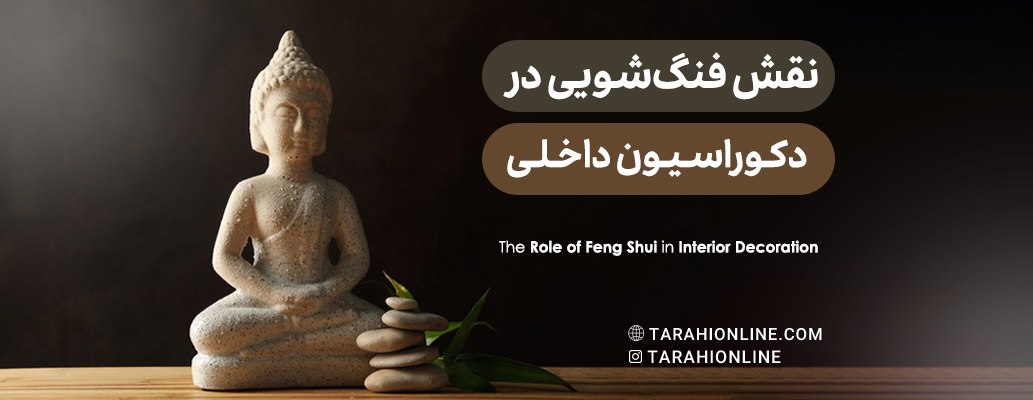
Feng Shui, an ancient Chinese art, influences interior space arrangements to improve the balance and harmony of energies. This philosophy, which is over three thousand years old, aids in enhancing health, happiness, and wealth. In this article, we will examine the role of Feng Shui in interior decoration and demonstrate how this ancient science can improve the quality of your life.
1. The Concept of Feng Shui
Feng Shui, meaning "wind and water," refers to the balance of positive energies (Chi) in living and working spaces. This philosophy believes that by properly arranging elements and objects in the environment, one can enhance the flow of positive energies and prevent negative ones. The principles of Feng Shui are based on five main elements—wood, fire, earth, metal, and water—each of which plays a significant role in the balance and harmony of a space.
2. The Impact of Feng Shui on Interior Decoration
Feng Shui can significantly influence interior decoration, creating a calm and harmonious environment. The principles of Feng Shui in interior decoration can be outlined as follows:
2.1. Choosing the Right Location for Furniture
One of the principles of Feng Shui is selecting the right location for furniture. For example, the bed should be placed in a position where the entrance door is visible but not directly in line with it. This positioning enhances the sense of security and peace in the bedroom.
2.2. Utilizing Natural Light
Natural light is recognized as one of the essential elements in Feng Shui. Using large windows and light curtains that allow natural light to enter the space can improve the flow of positive energies in the environment.
2.3. Arranging Objects and Decorations
In Feng Shui, the arrangement of objects and decorations is designed to facilitate the movement of positive energies easily through the space. This includes removing clutter and unnecessary items and creating a clean, orderly environment.
3. The Use of Colors in Feng Shui
Colors play a crucial role in Feng Shui, with each color possessing unique energy that can affect the space. For example:
-
Red: Red symbolizes energy and power, helping to enhance motivation and confidence. Using this color in workspaces can have positive effects.
-
Blue: Blue represents calm and peace, making it suitable for rest and sleep areas. This color can help reduce stress and increase tranquility.
-
Green: Green signifies growth and freshness, aiding in improving health and mental balance. Using this color in living and dining areas can have beneficial effects.
4. The Five Main Elements in Feng Shui
The five main elements in Feng Shui include wood, fire, earth, metal, and water. Each element plays a unique role in the space and can help improve the flow of positive energies.
-
Wood: Represents growth and energy. Using plants and natural wood in decoration can enhance health and vitality in the space.
-
Fire: Symbolizes energy and passion. Using candles and warm colors can increase motivation and energy in the environment.
-
Earth: Represents stability and balance. Using natural materials like stone and ceramics in decoration can increase balance and steadiness in the space.
-
Metal: Symbolizes strength and clarity. Using shiny metals and metallic colors can improve focus and mental clarity.
-
Water: Represents flow and flexibility. Using water features and blue colors can enhance tranquility and flexibility in the environment.
5. Practical Tips for Using Feng Shui in Interior Decoration
5.1. The Entrance
The entrance to the home is very important as it is the point where positive energies enter. Ensure that the entrance is clean and orderly and use beautiful plants and appropriate lighting to welcome positive energies.
5.2. The Bedroom
The bedroom should be a calm and comfortable place. Avoid placing mirrors directly opposite the bed, as this can bring negative energy into the bedroom. Using calm and soothing colors in bedroom decoration can improve sleep and increase relaxation.
5.3. The Living Room
The living room is a place for relaxation and connecting with family and friends. Arrange the furniture so that all members can easily interact with each other. Using warm and natural colors in the living room can convey a sense of warmth and intimacy.
5.4. The Kitchen
The kitchen, as a place for preparing food and nourishing the family, is very important. Avoid placing the stove and sink too close together, as this can disrupt the balance of water and fire energies. Using light and natural colors in the kitchen can improve energy and motivation while cooking.
As an ancient science and art of arranging living spaces, Feng Shui can help improve the quality of life and increase harmony and balance in the environment. By adhering to Feng Shui principles in interior decoration, one can introduce positive energies into the space and prevent negative ones. Proper furniture placement, the use of natural light, appropriate object arrangement, the right color choices, and the incorporation of Feng Shui’s five main elements can all contribute to improving the flow of positive energies in the space, bringing a sense of tranquility and happiness.